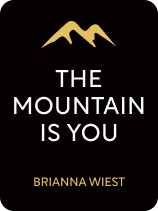

This article is an excerpt from the Shortform book guide to "The Mountain Is You" by Brianna Wiest. Shortform has the world's best summaries and analyses of books you should be reading.
Like this article? Sign up for a free trial here.
What is the key to becoming your ideal self? How do you know what you want out of life?
In The Mountain Is You, Brianna Wiest explains that becoming your ideal self will help you stop self-sabotaging behaviors. In her book, she provides two major steps to achieve this.
Let’s look at these two steps so you can learn how to become your ideal self.
Identify and Take Steps Toward Your Ideal Life
Once you’re able to overcome self-sabotage, follow your instincts, and effectively respond to your emotions, Wiest explains that you’ll have the skills necessary to become your ideal self and achieve your life purpose. There are two major steps to learning how to become your ideal self: First, identify your goal—ask yourself what you want to do in life and who you want to be. Second, develop principles that will guide your actions in life and help you take the steps necessary to achieve your purpose.
Step #1: Identify Your Purpose and Your Ideal Self
Wiest explains that you should strive for two goals: achieving your life purpose and becoming your ideal self. Your life purpose isn’t just a hobby or the job you do. Rather, it’s the point where your talents and passions converge with the needs of society—an activity that inspires and fulfills you but that’s also something that you can make a career out of. Your ideal self is the most powerful, successful, happiest, and productive version of yourself that you can imagine. Wiest offers two exercises to help you identify your life purpose and ideal self.
To identify your life purpose, Wiest recommends answering the following questions: What are you willing to work for, be challenged by, or even feel pain over? If you weren’t concerned about others’ approval, what would you choose as a career or aspire to do? What skills or activities come naturally to you or do you find yourself regularly engaging in? What would you do on an ideal day without considering work or obligations? What skills, values, or traits do you want to be remembered by?
To identify your ideal self, Wiest recommends engaging in a meditation with your future self. First, find a quiet place, sit down with a pen and paper, take deep breaths to center yourself, and release any fears or negative emotions. When you feel totally relaxed, visualize the highest version of yourself sitting across from you. Then, take note of how they look, behave, speak, and communicate through their body language; what are they wearing, how are they feeling, and what do they do every day?
Next, listen to the advice that this future self wants to give you, even if it’s something you might disagree with at first. This advice should be uplifting, caring, and helpful. Now, imagine the particular aspects of this person’s life that allow them to live their purpose—where they’re living, what job they’re doing, the relationships they have, their daily tasks, their habits, and so on. Finally, imagine them giving you the key to that life—their life, routines, behaviors, and skills are now yours. This final step will put you in an “action” mindset that encourages you to enact the tasks and behaviors necessary to become your ideal self.
Step #2: Develop Life Rules To Achieve Your Purpose and Ideal Self
Once you’ve identified your life purpose and the person you’d like to become, Wiest says you must create life rules that will help you achieve and maintain these goals—Wiest calls these principles. These rules should represent personal commitments that you believe in and that will shape your life in the long term. For example, if you have a life rule to cut ties with people who regularly make you feel bad, you’ll live a life surrounded by positive people who encourage you to be your best self. Life rules will help you make hard decisions and face difficult or triggering situations, encourage you to continually pursue your goals, and help you overcome barriers that may cause you to stray from your intended path. Living by your rules will ensure that you’re happy and always progressing toward the best version of yourself.
To create life rules, Wiest recommends making a list of things you value and genuinely care about, a list of feelings you want to experience regularly, and a list of things that make you uncomfortable or produce anxiety. Create rules that will help you reach the things you value, experience the feelings you desire, and manage the things that cause you anxiety.
For example, if you value travel, want to feel inspired throughout your life, and feel anxiety around financial issues, you can create the following life rule: “I’ll set aside money every month so I’ll be able to travel without having to worry about the financial burden of it. I’ll spend an hour each week researching travel locations to gain inspiration and foster my love for travel.”Ultimately, Wiest explains that these rules should pertain to every area of your life that’s important to you—this can be anything from finances to skill development, relationships, career building, communication, and so on. Most principles won’t result in immediate gratification, but over time, they’ll pave the path to achieving your life purpose and ideal self.

———End of Preview———
Like what you just read? Read the rest of the world's best book summary and analysis of Brianna Wiest's "The Mountain Is You" at Shortform.
Here's what you'll find in our full The Mountain Is You summary:
- Why the only thing standing in your way of achieving your goals is you
- How to achieve your life purpose and become your ideal self
- How to identify your self-sabotaging behaviors and stop them






